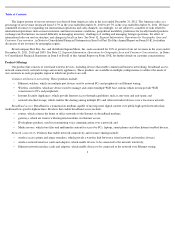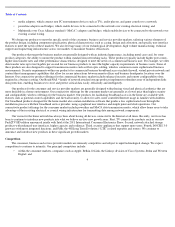Netgear 2011 Annual Report Download - page 17
Download and view the complete annual report
Please find page 17 of the 2011 Netgear annual report below. You can navigate through the pages in the report by either clicking on the pages listed below, or by using the keyword search tool below to find specific information within the annual report.
Table of Contents
Our stock price may be volatile and your investment in our common stock could suffer a decline in value.
With the continuing uncertainty about economic conditions in Europe, the United States and elsewhere internationally, there has been
significant volatility in the market price and trading volume of securities of technology and other companies, which may be unrelated to the
financial performance of these companies. These broad market fluctuations may negatively affect the market price of our common stock.
Some specific factors that may have a significant effect on our common stock market price include:
Some of our competitors have substantially greater resources than we do, and to be competitive we may be required to lower our prices
or increase our sales and marketing expenses, which could result in reduced margins and loss of market share.
We compete in a rapidly evolving and fiercely competitive market, and we expect competition to continue to be intense, including price
competition. Our principal competitors in the commercial business market include Allied Telesys, Barracuda, Buffalo, Data Robotics, Dell, D-
Link, Fortinet, Hewlett-Packard, Huawei, Cisco Systems, the Linksys division of Cisco Systems, QNAP Systems, Seagate Technology,
SonicWALL, Synology, WatchGuard and Western Digital. Our principal competitors in the home market for networking devices and television
connectivity products include Apple, Belkin, D-Link, the Linksys division of Cisco Systems, Roku and Western Digital. Our principal
competitors in the broadband service provider market include Actiontec, ARRIS, Comtrend, D-Link, Hitron, Huawei, Motorola, Pace, Sagem,
Scientific Atlanta-a Cisco company, SMC Networks, TechniColor, Ubee, Compal Broadband, ZTE and ZyXEL. Other current and potential
competitors include numerous local vendors such as Devolo, LEA and AVM in Europe, Corega and Melco in Japan and TP-Link in China. Our
potential competitors also include other consumer electronics vendors, including LG Electronics, Microsoft, Panasonic, Samsung, Sony, Toshiba
and Vizio, who could integrate networking and streaming capabilities into their line of products, such as televisions, set top boxes and gaming
consoles, and our channel customers who may decide to offer self-branded networking products. We also face competition from service
providers who may bundle a free networking device with their broadband service offering, which would reduce our sales if we are not the
supplier of choice to those service providers. In the service provider space, we are also facing significant and increased competition from original
design manufacturers, or ODM’s, and contract manufacturers who are selling and attempting to sell their products directly to service providers
around the world.
Many of our existing and potential competitors have longer operating histories, greater name recognition and substantially greater
financial, technical, sales, marketing and other resources. These competitors may, among other things, undertake more extensive marketing
campaigns, adopt more aggressive pricing policies, obtain more favorable pricing from suppliers and manufacturers, and exert more influence on
sales channels than
13
•
actual or anticipated fluctuations in our operating results or our competitors
’
operating results;
•
actual or anticipated changes in the growth rate of the general networking sector, our growth rates or our competitors
’
growth rates;
•
conditions in the financial markets in general or changes in general economic conditions, including government efforts to stabilize
currencies;
•
interest rate or currency exchange rate fluctuations;
•
our ability or inability to raise additional capital;
•
our ability to report accurate financial results in our periodic reports filed with the SEC;
•
disclosures of previously non-public information in connection with our segment reporting, which commenced in the second fiscal
quarter of 2011; and
•
changes in stock market analyst recommendations regarding our common stock, other comparable companies or our industry
generally.
























